Oregon vs Colorado: A prehistoric series, part II
October 9, 1955 – Hayward Field –
Colorado 13, Oregon 6
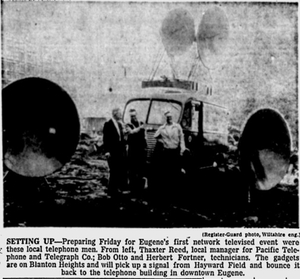 Feature photo, Register-Guard, 10/8/1955The big news in early October 1955 was television.
Feature photo, Register-Guard, 10/8/1955The big news in early October 1955 was television.
The Colorado contest was to be the first “network-televised” event originating from Eugene.
Unfortunately, viewers in Eugene couldn’t see the game – not because of blackouts, which hadn’t yet been invented; it was broadcast regionally on CBS, and Eugene didn’t have an affiliate on that network.
It was theoretically possible to pick up the KOIN signal from Portland, if you lived in the right places and had a huge antenna and the wind was blowing in a southerly direction and you had a high tolerance for fuzzy pictures.
Still, the telecast was front-page news, further proof that the modern world had finally reached “Oregon’s 2nd Market.”
Of course, no satellites had been launched in the fall of 1955 to carry television signals. Thus, the remote telecast was strictly terrestrial. A microwave link was set up at Hayward Field to beam the signal to Blanton Heights south of Eugene, where the signal was reflected via “gadgets” to the main Bell office downtown; from there, the signal went onto coaxial cable, with the next stop the CBS switching office in Sacramento and points beyond.
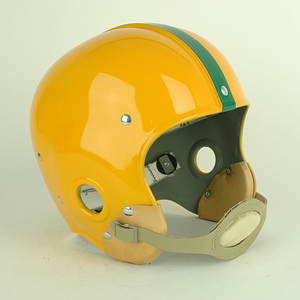 God bless HelmetHutThat any of this worked at all is as much a miracle as the fact that Colorado won the 1955 game, in a muddy mosh pit, despite being outgained 366-220, hit with nearly 100 yards of penalties and punting 9 times. It was old-time home team generosity that won it for the Buffs, as the Webfoots laid the ball on the turf 8 times and lost six of those – five drive-killers inside the
God bless HelmetHutThat any of this worked at all is as much a miracle as the fact that Colorado won the 1955 game, in a muddy mosh pit, despite being outgained 366-220, hit with nearly 100 yards of penalties and punting 9 times. It was old-time home team generosity that won it for the Buffs, as the Webfoots laid the ball on the turf 8 times and lost six of those – five drive-killers inside the 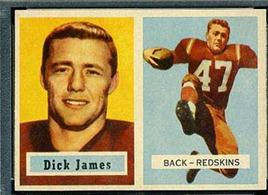 Colorado 35, and one on their own 29 that led to Colorado’s first score.
Colorado 35, and one on their own 29 that led to Colorado’s first score.
The young Ducks had lots of speed in the backfield with Jim Shanley, Jack Crabtree and Jack Morris, all sophomores who would prove themselves as leaders of the 1957 conference champions. But the team leader and captain in 1955 was senior Richard Alwin James from Grants Pass, better known as “Dick.” Dick James was a diminutive halfback who torched the big Colorado defense for 123 yards on 18 carries. Oregon’s Hoffman Award winner for 1955, at season’s end James was named to the Colorado “All-Opponents” team, was second team All-Coast and received honorable mention at halfback on the UPI All-America team.
James went on to a ten year NFL career, mostly with Washington, where he established a team record with four touchdowns in a single game against the Cowboys in 1961. James led the Redskins in rushing three straight years, despite being generously listed at 5’9” and 175 lbs.
September 22, 1956 – Folsom Field –
Oregon 35, Colorado 0
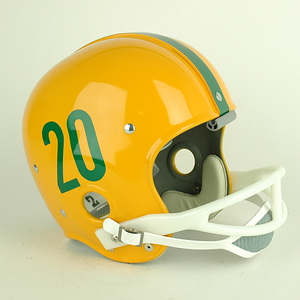 God bless HelmetHutThe Ducks, sporting new helmets with the space-age innovation of face masks, opened 1956 on the road at the newly remodeled Folsom Field. Crews had spent a year adding an upper deck to the venerable wooden stadium, nearly doubling the capacity to 45,000 fans. The opener didn’t sell out, but over 40 thousand showed up to see a halftime extravaganza featuring 73 high school marching bands performing simultaneously – presumably, not the Theme from Star Wars.
God bless HelmetHutThe Ducks, sporting new helmets with the space-age innovation of face masks, opened 1956 on the road at the newly remodeled Folsom Field. Crews had spent a year adding an upper deck to the venerable wooden stadium, nearly doubling the capacity to 45,000 fans. The opener didn’t sell out, but over 40 thousand showed up to see a halftime extravaganza featuring 73 high school marching bands performing simultaneously – presumably, not the Theme from Star Wars.
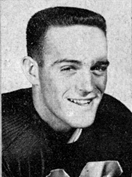 Jim Shanley
Jim Shanley
They also saw their Buffaloes get pasted by Len Casanova’s Webfoots. The altitude and huge crowd, a state record for Colorado, didn’t seem to bother Oregon a bit; as was typical for Cas’s early teams, the ground game ruled, but this time the defense stepped up. Oregon’s backs rumbled for 364 yards on 60 carries; Colorado was held to just 7 first downs and 102 yards total for the game. Junior HB Jim Shanley was the star of the game, running for 71 yards and grabbing a 64 yard TD pass from Tom Crabtree in the third.
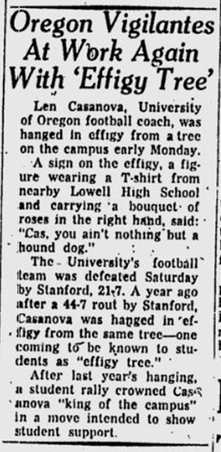 The blowout wasn’t much of a reflection on future performance.
The blowout wasn’t much of a reflection on future performance.
The Ducks would post a very average 4-4-2 record for 1956, going 0-for-October, only scoring three TDs all month; they apparently used up their touchdown allotment against Colorado. After another loss to Stanford, Cas was hanged in effigy from a campus tree, again.
And Colorado? The Buffs finished second in the Big Seven, but since unbeaten Oklahoma had gone to the Orange Bowl after the previous season, and the conference had a no repeat rule, the Sooners sat home for the holidays and won another national title. Meanwhile, Colorado got the Orange Bowl bid, beat Clemson and finished 8-2-1.
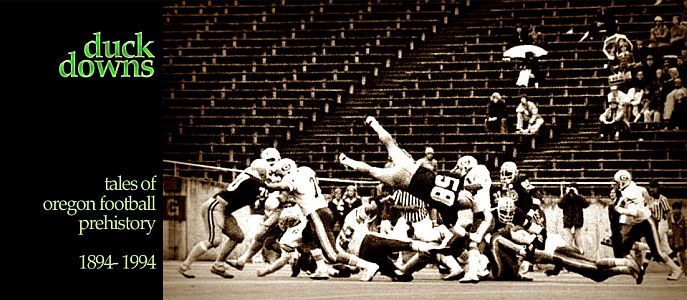
 benzduck
benzduck
Reader Comments (2)
Benzduck,
I love the look of your site, very vintage, very cool, and admire the meticulous research. Do you have any information on Ducks who served in WWII, Korea, Vietnam or the MIddle East? It would be an interesting angle on this Memorial Day weekend. An internet search yielded nothing.
Best wishes, and continued success with Tales of Oregon Prehistory.
Oh, check the typo in paragraph one of September 1956. Jim Shanley is inadvertently inserted in the sentence about the marching bands. He was versatile, but not quite that versatile.
Dale
Hi Dale -- thanks for the kind words and the eagle-eye on the Shanley typo.
I've thought about doing an article on Oregon WWII vets and their impact on the program after returning to school following the war. The great lineman Brad Ecklund was one of several members of the '48 Cotton Bowl squad who started their career before the war and came back. Ecklund credited his time in the Pacific theater with maturing him as a person and focusing his on-field performance.
WWII was different than Korea or Nam or subsequent conflicts, because the team shut down for a couple of years altogether. I don't know about Korea, but any student athlete during the Vietnam years would have had to be a volunteer, since deferral of service for students meant they weren't subject to the draft. I think there were a few Nam vets on the roster in the 70s.
It would be real interesting to look into other Ducks who played before, or after, serving their country. I'll try to pull something together by Veterans Day.